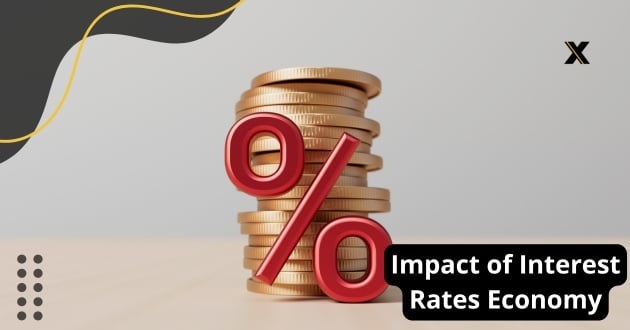Anúncios
The impact of interest rates economy cannot be overstated, as interest rate policies act as one of the strongest levers available to central banks in shaping the direction of economic activity.
Far from being just a technical adjustment in monetary policy, these decisions influence the way individuals spend, save, and invest, while also determining how businesses expand, innovate, and hire. They create ripples that travel through financial markets, labor markets, and international trade, ultimately shaping the standard of living in societies around the globe.
To understand this dynamic more clearly, it is essential to recognize that interest rates are more than numbers announced in press releases. They represent the cost of money itself, the very foundation of modern economies.
A decrease in rates can spark waves of consumption and business investment, stimulating growth and innovation. On the other hand, a rise in rates can slow down credit, cool overheating markets, and bring inflation back under control.
Anúncios
Therefore, the impact of interest rates economy extends well beyond finance, it determines how accessible housing becomes, how profitable companies remain, how much people can save for retirement, and even how currencies perform in global trade.
Historical Context of Interest Rates
The history of interest rates shows how governments and central banks have long used them as instruments of control and stability. From early European banking systems to the Great Depression, adjustments in borrowing costs were crucial to either stimulate growth or restrain excessive speculation.
Over time, these policies became the backbone of modern economies, influencing both domestic consumption and global trade.
During the post–World War II era, interest rates were employed to rebuild nations and foster industrial expansion. However, the 1970s introduced stagflation, a period of high inflation combined with stagnant growth.
To counter this, central banks raised rates aggressively, proving that interest rates are not only tools for promoting growth but also mechanisms for defending price stability. These historical lessons still guide monetary authorities today.
As financial markets became increasingly globalized in the late 20th and early 21st centuries, interest rate decisions in one country began to affect the entire world. For instance, when the U.S. Federal Reserve changes its policy, emerging markets, commodity prices, and currencies across continents react immediately. This demonstrates that Global Economic Factors Affecting US decisions are deeply interconnected with worldwide economic performance, shaping strategies well beyond American borders.
Even small adjustments can trigger significant ripple effects. A one-point increase may discourage borrowing and cool down overheated housing markets, while a slight cut can inspire new investment and consumer optimism.
Therefore, the historical context reveals not only the sensitivity of modern economies to interest rate changes but also the importance of viewing them through a global lens, where past experiences and future uncertainties continuously interact.
The Mechanism of Transmission
Another crucial aspect when analyzing the impact of interest rates economy is the transmission mechanism. Central banks, such as the Federal Reserve in the United States or the European Central Bank in Europe, do not control the economy directly. Instead, they influence it through a chain reaction.
First, interest rate decisions affect the cost of borrowing for commercial banks. Then, those banks adjust the rates they charge for loans and mortgages. As households and companies respond to these changes, consumer spending, corporate investment, and credit demand evolve. Finally, these shifts aggregate into broader macroeconomic outcomes, such as employment rates, GDP growth, and inflation levels.
Influence on Consumer Behavior
The impact of interest rates economy is clearly visible in consumer behavior. When borrowing costs are low, people are more inclined to finance large purchases such as homes, cars, or education. Additionally, low interest rates often reduce the incentive to save, encouraging individuals to spend more in the present.
On the other hand, higher rates make loans more expensive and savings accounts more attractive. This shift reduces demand for goods and services, slowing down the pace of economic growth. As a result, consumer confidence and household budgets directly reflect central bank policies.
Corporate Investments and Business Growth
Transitioning from households to businesses, the impact of interest rates economy also dictates corporate strategies. Lower borrowing costs encourage companies to expand, innovate, and hire new employees. With cheap credit available, businesses can take risks, invest in technology, and open new markets.
Nevertheless, when interest rates rise, businesses face a different reality. Financing costs increase, profit margins shrink, and expansion plans may be postponed or canceled. Consequently, unemployment rates may rise as companies cut expenses, which further affects overall economic stability.
Real Estate Market Dynamics
Few sectors are as sensitive to interest rate movements as real estate. Mortgages, after all, represent one of the largest forms of consumer debt. The impact of interest rates economy becomes visible when analyzing housing affordability.
When interest rates are low, mortgage payments decrease, making it easier for families to buy homes. This stimulates construction, increases property values, and generates demand in complementary industries such as furniture, appliances, and home improvement. However, when rates climb, the exact opposite occurs: housing demand falls, prices stabilize or decline, and construction projects slow down.
Stock Market Reactions Impact of Interest Rates Economy

In addition to real estate, the stock market also reacts strongly to interest rate decisions. The impact of interest rates economy is felt in valuations, investor sentiment, and capital flows.
Lower rates make bonds and savings accounts less attractive, leading investors to allocate more money to equities. As a result, stock markets often rise during periods of low interest rates. Conversely, when central banks raise rates, bond yields increase, drawing capital away from stocks. This reallocation typically pressures stock markets, sometimes triggering corrections or long-lasting bear markets.
Employment and Wage Growth
Another area where the impact of interest rates economy becomes evident is the labor market. Low interest rates encourage expansion, leading companies to hire more workers. This often pushes unemployment down and may result in wage increases, as firms compete for skilled employees.
However, when central banks tighten monetary policy, the ripple effect reduces investment and hiring. Over time, unemployment may rise, and wage growth can stagnate. Policymakers must therefore balance the desire to control inflation with the risk of undermining job creation.
Global Trade and Currency Values
Transitioning to the international perspective, the impact of interest rates economy also extends to exchange rates and trade flows. Higher interest rates in a given country usually attract foreign capital, strengthening its currency. While this may benefit consumers who import goods, it can harm exporters by making their products more expensive abroad.
Conversely, lower rates may weaken the currency, stimulating exports but raising the cost of imports. These dynamics show how domestic monetary policy inevitably shapes international competitiveness and geopolitical relations.
The Inflation Connection Impact of Interest Rates Economy
Inflation control is perhaps the most direct reason behind interest rate adjustments. The impact of interest rates economy is often discussed in terms of how effectively central banks can keep inflation at target levels.
When inflation rises too quickly, higher interest rates discourage borrowing and spending, cooling demand and stabilizing prices. In contrast, when inflation is too low, central banks lower rates to stimulate activity and avoid deflationary spirals. Achieving the right balance is extremely complex, as policymakers must anticipate future conditions rather than simply reacting to current data.
Social and Distributional Effects
Beyond technical aspects, the impact of interest rates economy has profound social implications. For instance, low interest rates may benefit younger generations who rely on loans for housing or education, but they harm retirees who depend on fixed-income savings. Similarly, higher rates may favor savers but disproportionately affect low-income households that live on credit.
This distributional effect highlights the importance of interest rate policy not only as an economic tool but also as a matter of fairness and social stability.
Conclusion
In conclusion, the impact of interest rates economy is far more complex than a simple adjustment in monetary policy. It represents a powerful mechanism that directly shapes consumer spending, corporate investment, housing affordability, employment levels, and even global trade relations. Therefore, understanding how central banks use this tool is crucial for policymakers, businesses, and households alike.
Moreover, it is important to recognize that interest rates operate not only at the domestic level but also across borders. When the U.S. Federal Reserve or the European Central Bank alters its rates, the effects are felt worldwide.
Capital flows, exchange rates, and commodity markets all respond quickly, proving that monetary policy decisions are truly global in scope. For this reason, Global Economic Factors Affecting US policy choices end up influencing the prosperity and stability of economies far beyond American borders.
At the same time, interest rate adjustments are never without risk. Prolonged low rates can fuel bubbles in housing or equities, while aggressive hikes can lead to recessions or spikes in unemployment.
Consequently, central banks must act with caution, balancing inflation control with economic growth and financial stability. They must also remain transparent and communicate their strategies clearly, since public expectations are often just as influential as the policy moves themselves.
Ultimately, the challenge lies in maintaining equilibrium. Interest rates must be set at levels that sustain long-term growth without creating imbalances or social inequalities.
For those who want to explore more on how monetary policy decisions are made, the official website of the Federal Reserve provides detailed insights into current policies, frameworks, and global impacts. By studying both the history and future of interest rates, one can better appreciate their role as one of the most powerful forces shaping our economic lives.




